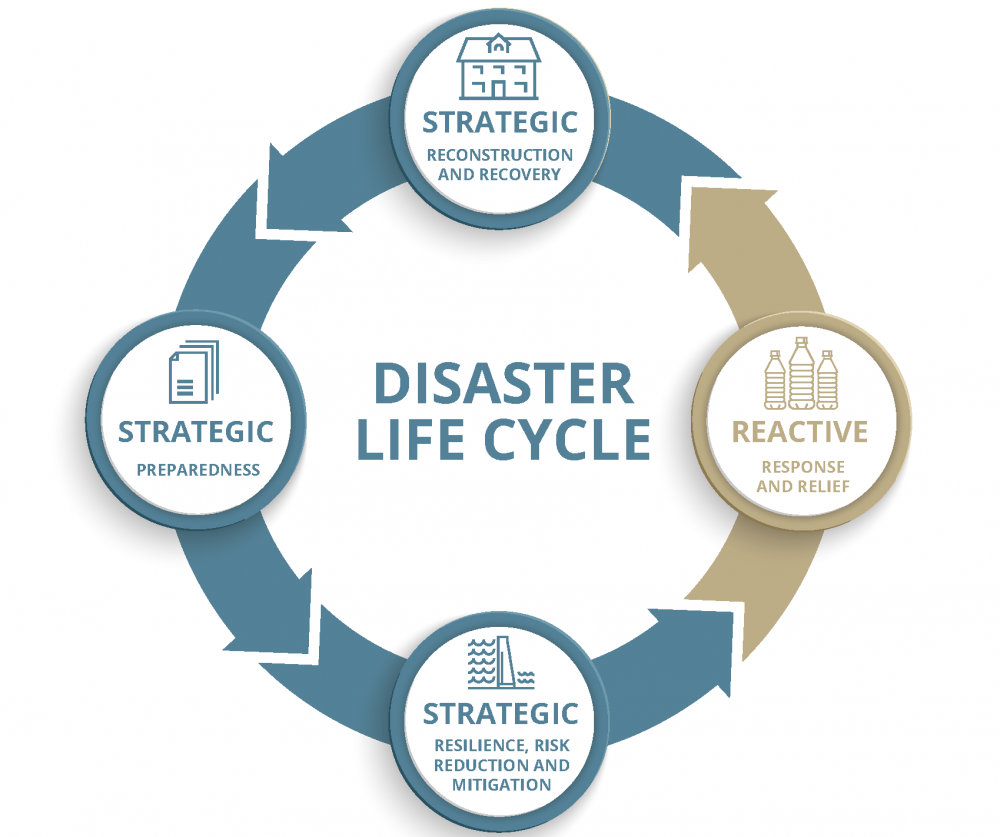Last Tuesday, 2,750 tons of ammonium nitrate exploded in a warehouse in Beirut, Lebanon, killing over 157 and injuring thousands more. With the force of a 3.5 magnitude earthquake, this explosion damaged landmarks, businesses, and homes up to 15 miles away and was heard over 100 miles away.
The nation had already been battling an economic crisis, political unrest, and COVID-19 outbreaks, and the disaster has only exacerbated existing conflicts and crises. Hospitals overwhelmed with COVID-19 patients now lack the capacity to treat those injured from the explosions. Communities already experiencing daily power cuts, lack of drinking water, and limited healthcare now face a crisis of homelessness affecting over 300,000. Angered by the government’s leadership and response, citizens have turned to the streets in protest, calling for sweeping reform.
As aid organizations and other government leaders began pledging humanitarian aid and planning for recovery, I wondered how a disaster of this magnitude could have occurred and how the world should respond. UN Special Representative of the Secretary-General for Disaster Risk Reduction Mami Mizutori makes an interesting point: “This traumatic event provides a stark reminder that disaster risk is systemic; we cannot see disasters in isolation. Disasters weaken entire systems and cascading impacts are felt across all aspects of life affecting the most vulnerable.”
What should we know about disaster mitigation and response more broadly?
The Disaster Life Cycle
The Center for Disaster Philanthropy proposes a four-phase cycle for understanding disasters and our response to them. While we tend to think of disasters solely in terms of relief, this “disaster life cycle” provides a more holistic framework for addressing their prevention and mitigation.

- Mitigation
Disaster mitigation seeks to prevent future emergencies or reduce their harmful impact. Continually recognizing and assessing risk is crucial to this phase.
The UN Office for Disaster Risk Reduction defines risk as “the function of the combined effects of hazards, the assets or people exposed to hazard and the vulnerability of those exposed elements.” A holistic risk assessment involves evaluating social, economic, political, cultural, technical, and environmental conditions of communities and organizations on multiple levels and across sectors.
For example, vulnerable populations are at the highest risk and should be prioritized in disaster preparation. These populations—the elderly, poor, chronically ill, homeless, incarcerated, and refugees—should be supported through capacity building in agencies and organizations that work with them and through strategic plans for emergency communications and mobilization of community leaders.
- Preparedness
Disaster preparedness involves creating plans for timely and effective relief and response to be implemented in the case of a disaster.
Using the appropriate risk assessment, this might involve stockpiling equipment and supplies, arranging for the distribution of those supplies, and planning for mass communication and mobilization of key players. Philanthropy and funding can also target these initial phases by proactively supporting efforts to build resilience, rather than solely responding to emergencies. Research suggests that every $1 spent on disaster preparedness saves $7 in damage.
- Response
Disaster response or relief occurs immediately after an emergency and focuses on alleviating the short-term needs of the communities affected. Usually given the most attention, this phase implements disaster response plans and seeks to save live lives, minimize property damage, and mobilize support.
Organizations such as the Red Cross and Samaritan’s Purse are most commonly known for this type of relief, providing assistance in the form of food donations, blood drives, temporary housing, emergency supplies, health services, and volunteer support.
- Recovery
Although the line between response and recovery is not always clear, recovery aims to rebuild affected communities and reduce future risk. This phase can last for months or even years, as damages are assessed and efforts shift from relief to empowerment.
In this phase, both physical structures and social capital should be rebuilt and redesigned. For example, communities in high risk areas that suffer from chronic fires or floods might be relocated. They might also design education, training, and public awareness campaigns to minimize future risk. Utilizing partnerships across nonprofit organizations, government leaders, and community leaders can help ensure holistic restoration.
How can understanding the disaster cycle impact our efforts?
Understanding the four phases of the disaster cycle as well as its cyclical nature can help us better serve those affected by disasters, as well as prevent and mitigate future crises. Rather than letting the media direct our efforts solely towards disaster response, we should consider how we can steward our time and resources for disaster mitigation, preparedness, and recovery.
We might commit to supporting organizations that empower vulnerable populations and efforts to build capacity among community members. We can encourage communication among community leaders, government officials, and agency and organization leaders to create plans for mobilization and emergency response. And as disasters occur, we should commit to investing in long-term recovery, recognizing that needs persist long after media attention shifts elsewhere.
How can we help Beirut?
Donate to help meet critical immediate needs, including medical support, housing, and food—especially for vulnerable populations. Also consider supporting organizations committed to long-term recovery efforts including job recovery, food security, and rebuilding of infrastructure.
Here are some organizations you might support as relief efforts continue:
For more information about the disaster cycle and disaster philanthropy, check out the UN Office for Disaster Risk Reduction, Federal Emergency Management Agency, Disaster Philanthropy Playbook, or Center for Disaster Philanthropy.
- Beirut and the Disaster Life Cycle - August 10, 2020
- What You Should Know About the Uighur Human Rights Crisis - July 28, 2020
- “Slacktivist” to activist - July 13, 2020
